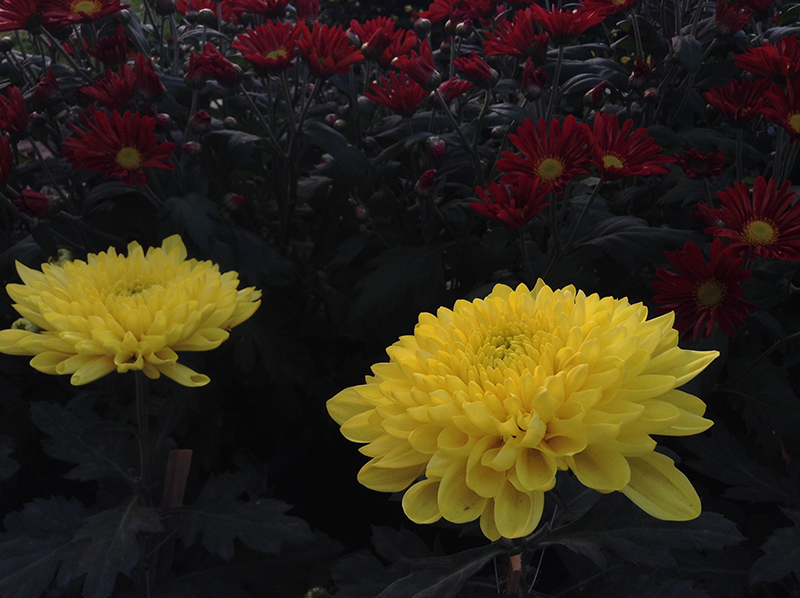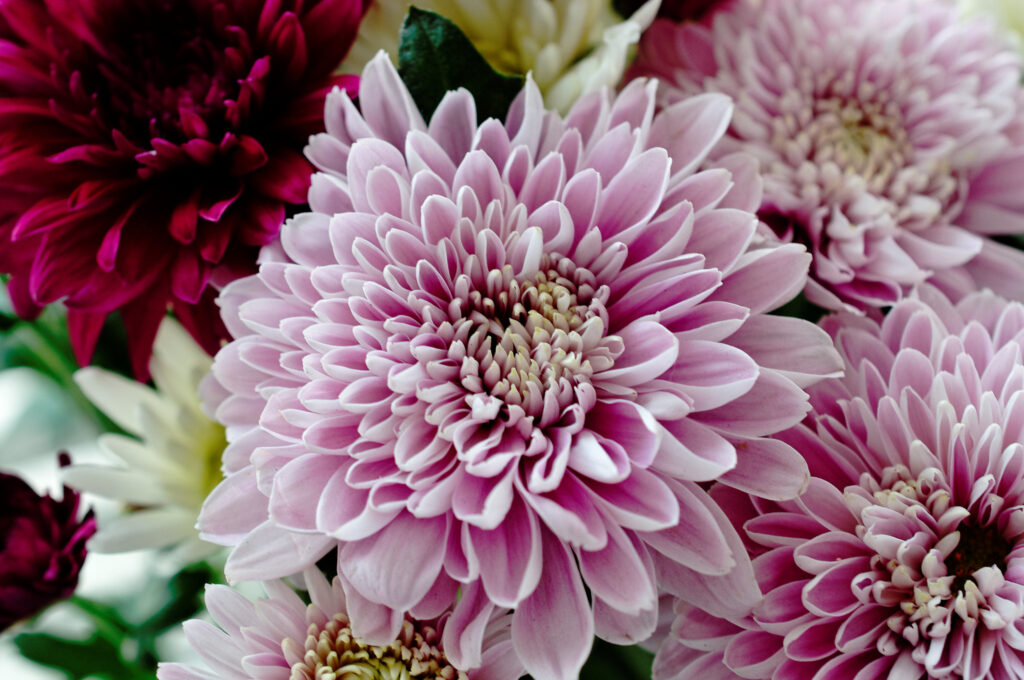Chrysanthemums, often just called “Mums,” are members of one of the largest families of flowering plants, the Asteraceae family. This group includes well-known flowers like daisies, sunflowers, zinnias, dahlias, and even dandelions. Flowering herbs and vegetables like artichokes, yarrow, and echinacea are also all relatives of this beautiful flower. The Chrysanthemum was first cultivated in ancient China and was used as a medicinal herb as well as a flower. It has a long history in the Far East, including Japan, and is cultivated all over the world. This plant is still used as an herbal cold remedy and for a variety of other ailments.
Categories of Chrysanthemums
There are two main categories of Chrysanthemum. The first group is the hardy perennial plant types, commonly called “Garden Mums.” These are usually grown in the garden, and they will bloom and grow for years with minimal maintenance. Chrysanthemum x morifolium, a hybrid, is the most common Garden Mum in the United States, but there are dozens of varieties of heirlooms and hybrid perennials. This second group, known as “Florist Mums” are usually grown as annuals in containers. They are a bit more comfortable in warm weather, and while they technically are perennials, they are usually grown as annuals. They are popular house plants. Florist Mums can sometimes grow in the garden as perennials if cared for properly in warmer climates, but they are less likely to come back. In the US, Chrysanthemum multicaule is the most common of the many types of Florist Mums. The potted Chrysanthemum can help purify the air in your house! There was a NASA study in 1989 that showed Florist Mums can help filter formaldehyde and other chemicals from the air. The flower colors vary, based on the variety, from red to pink, purple, orange, yellow, white, or even multi-colored.

Chrysanthemum tea, made from the plant’s dried flower petals, is one of the most common ways of using it as an herbal remedy. The tea is high in potassium, Vitamin A, and various B vitamins. It helps with inflammation and eye irritation symptoms. It relaxes the body and improves focus, without caffeine!
- Chrysanthemum
- Garden Mums are perennial, Florist Mums are technically perennial, but are less hardy, and are
usually grown as annuals.
- Full Sun
- Moist and well-drained soil, from mildly acidic to mildly alkaline (6.0 to 8.0 pH).
- Start seedlings indoors, several weeks before the last frost
- Plant in the garden 2 weeks after the last frost in spring.
- Plant 18″ apart
- Growing in containers:
Ensure good drainage
Ensure full sun
- Water regularly, keeping the soil moist.
- Climate Zones 4-9 for perennial (garden mum) varieties
- Climate Zones 7-9 for annual (florist mum) varieties if growing outdoors.
Planting Chrysanthemums
If planting from seed, for either garden mums or florist mums for containers, start the seeds indoors about eight weeks before the last frost. Ensure warmth and light, and the seeds should germinate and sprout 2-3 weeks after starting them. Remove the weakest seedlings. Transplant to a larger pot once they have two leaves.
For perennial Garden Mums, harden your seedlings before planting. Take them outside for a few hours each day, then move the pots outside after the last frost in spring. Two weeks after the last frost, plant your flowers in the garden, about 18 inches apart. Dig a hole slightly larger than the roots and fill it in with good garden soil. Planting in the spring ensures that the root system will grow strong as the plant matures through the spring and summer for bountiful blooms in the first year. Keep them well-watered. The flowers will bloom late in the summer and in early fall. The full growth of the roots over the spring and summer ensures that the Chrysanthemum will be healthy and strong enough to survive the winter.

For fuller plants and more blooms, pinch the garden mums back during the summer season. Once they are 4 to 6 inches in height, pinch off the top blooms of the plant. This will cause the growth to split, and allow for more blooms. Do this every two to three weeks, keeping the plant at about 6 inches in height until the middle of July, then allow them to grow freely. This allows for the best flowering in late summer and into the fall. Chrysanthemums flower once the days begin to shorten. High temperatures (in the 80’s °F) will delay flowering. Cooler temperatures don’t have any effect unless it’s consistently below 50°F or so.
For starting potted plants, replant florist mums into a larger container, about 12 inches across, with fertile potting soil. For seeds you started yourself, just gently replant them. For plants already started and purchased from a flower shop, it’s important to first loosen the roots. It’s common for them to be a bit tangled up. Ensure that the final container is large enough and has excellent drainage.
Chrysanthemums can also be started from cuttings. This is a much faster process than growing from seed, and this works well for any perennial, including hybrids like the Chrysanthemum x morifolium. Take a few cuttings from existing plants in the late spring or early summer, by cutting a 3-inch shoot from the plant when they are still about 6 inches tall. Cut the leaves off the bottom half of the cutting, and plant it in a small container up to the leaves on the top half of the cutting (about 1 ½ inches deep). Keep moist, and add a rooting hormone if desired. It should produce roots in about 3 or 4 weeks. Keep them growing it in their pot until well into summer, the first week of July is usually best. It can then be transplanted to the garden, 18 inches apart like new seedlings, and they will grow normally.
Chrysanthemums as Companion Plants
They are also great companion plants! They are a go-to plant for other flowers or even vegetables because they naturally help prevent many pests. They naturally deter ticks, ants, Japanese beetles, moths, thrips, cutworms, and several other species of pests. They produce chemicals that are toxic to insects called pyrethrins. Chrysanthemums are however susceptible to aphids, leaf miners, and spider mites. Some of the diseases that they are prone to include leaf spots, wilt, and powdery mildew. Prevention is the best way to deal with both diseases and pests. Mums need regular watering, but avoid watering from overhead sprays. Watering at ground level keeps them healthy but prevents some possible infections that can weaken them and make the mums more susceptible to pests. Neem oil is a good preventative for powdery mildew and other fungal diseases if there is a risk of infection. Neem oil is also an effective organic cure for many pests when diluted with water if pests do become a problem. Other insecticides can be used if needed.

Harvesting Chrysanthemums
Harvesting chrysanthemum seeds takes some time and work. Heirloom seeds should be used for seed propagation, to ensure that the plant breeds true. The mum seeds grow in the flowers of the plant. They can be gathered in the fall after the flowers wilt and the stem turns completely brown. The seeds ripen gradually, with the flowers at the bottom of the stem producing the first mature seeds. They don’t continue to ripen after picking, so it’s important to allow the stems and flowers to fully turn brown before plucking or cutting them. This may need to be done in stages, harvesting them over time, with the ones lowest on the stem being cut first, or you can wait until they are all dry and brown. Once the flowers are completely dry, cut them off, allow them to completely dry for a few days, and strip the seeds from them. Spread the seeds on a sheet of paper (plain paper or a paper towel is fine). Allow them to dry for another day or so, and then save them in a dry container for starting again in the spring.
This easy-to-grow beautiful flower is versatile, and will be a great addition to your garden or potted plants! Use Garden Savvy’s garden planner, Hortisketch, to include Chrysanthemums in your garden design.

Contact Author
 info@gardensavvy.com
info@gardensavvy.com Recent Posts
- Smart Gardening: How Technology Is Revolutionizing Horticulture
- Understanding Gardening Zones: What You Need to Know
- The Right Tools For Your Gardening And Landscaping Needs
- Maximizing Your Harvest: Square Foot Gardening Chart for Beginners
- Holiday Garden Scents: Plants for Natural Aromatherapy in Your Home






